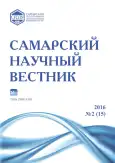Содержание понятия «арт-композиция» в контексте художественного образования XXI века
- Авторы: Калинина Л.Ю.1
-
Учреждения:
- Самарский государственный социально-педагогический университет
- Выпуск: Том 5, № 2 (2016)
- Страницы: 162-165
- Раздел: 13.00.00 – педагогические науки
- URL: https://journals.rcsi.science/2309-4370/article/view/22110
- DOI: https://doi.org/10.17816/snv20162306
- ID: 22110
Цитировать
Полный текст
Аннотация
В статье рассматривается содержание понятия «арт-композиция», функционирующее в практике педагогов-музыкантов, учителей изобразительного искусства и литературы, педагогов дополнительного образования по хореографии и театру. Однако теоретическое обоснование арт-композиции и содержание данного понятия до сих пор не были предметом специального изучения. В то же время, осмысление инновационного подхода в обучении искусству, характеризующегося ориентацией содержания художественного образования на учащегося – человека с современным мировоззрением, необходимо. Возникла потребность обогащения тезауруса школьной педагогики понятными, актуальными терминами, к числу которых относится «арт-композиция». Проведенное исследование вносит свой вклад в проблему более общего характера – возможности использования творческой полихудожественной деятельности как средства выявления и обучения одаренных детей. Своеобразие арт-композиции заключается в инновационном мышлении современного автора, стремящегося изображать мир не так, как его видит, а как понимает. Результат творчества поэтому может быть представлен разными художественными формами, не исключая эскизов, импровизаций, постмодернистской «игры» с текстом. Педагогическая ценность арт-композиции: учитель может наглядно отслеживать процесс развития ученика в сфере эстетического восприятия, ассоциативного мышления, работы с материалом.
Полный текст
Открыть статью на сайте журналаОб авторах
Лариса Юрьевна Калинина
Самарский государственный социально-педагогический университет
Автор, ответственный за переписку.
Email: klar1992@gmail.com
кандидат педагогических наук, доцент кафедры музыкального образования
Россия, СамараСписок литературы
- Deleuze G., Guattari F. Capitalisme et schizophrénie 2: Mille plateau. Collection «Critique». Les Éditions de Minuit, 1980. 648 p.
- Boddy-Evans M. Art Composition Rules: Rule of Thirds [Электронный ресурс] // http://painting.about.com.
- Baхter L., Thompson S. Art Composition [Электронный ресурс] // http://promotingartists.com.
- Гимпельсон Е.Г. Системные характеристики композиции риторического произведения: автореф. дис. … канд. филол. наук. Волгоград, 1998. 24 с.
- Гончарова М.А. Полиметрическая композиция в авторском лирическом стихотворном цикле ХХ века как смыслообразующий механизм: автореф. дис. … канд. филол. наук. Тверь, 2011. 28 с.
- Дегтяникова Н.И. Эвристические методы в исследовании композиции произведений изобразительного искусства: автореф. дис. … канд. иск. СПб., 2004. 26 с.
- Калакуцкая Е.Н. Композиционное понятие завершенности в изобразительном искусстве: дис. … канд. иск. СПб., 2002. 173 с.
- Смелкова З.С. Литература как вид искусства. М.: Флинта, 1997. 280 с.
- Халшев В.Е. Композиция // Литературная энциклопедия терминов и понятий / Гл. ред. и сост. А.Н. Николюкин. М.: Интелвак, 2001. С. 387–388.
- Eco U. Postille al nome della rosa. Added to the pocket italian edition, Milano: Bompiani (Commented edition, ed. by Costantino Marmo. Milano: Edizioni Scolastiche Fabbri), 1984. 48 с.
- Кожинов В.В. Композиция // Краткая литературная энциклопедия / Гл. ред. А.А. Сурков: В 9 т. Т. 3. М.: Советская энциклопедия, 1978. С. 694–696.
- Композиция // Музыкальная энциклопедия / ред. Ю.В. Келдыш: В 6 т. Т. 2. М.: Советская энциклопедия. Советский композитор, 1974. С. 892–895.
- Лучинская Е.Н. Постмодернистский дискурс: автореф. дис. … канд. филол. наук. Краснодар, 2002. 46 с.
- Куприянова Л.А. Семантика музыкальной композиции: автореф. дис. … канд. иск. Магнитогорск, 2000. 24 с.
Дополнительные файлы






